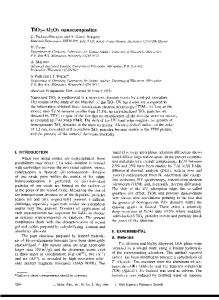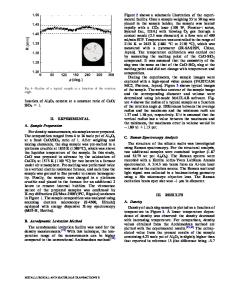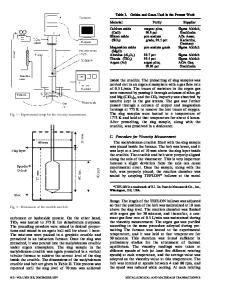Viscosity of TiO 2 -FeO-Ti 2 O 3 -SiO 2 -MgO-CaO-Al 2 O 3 for High-Titania Slag Smelting Process
- PDF / 3,338,040 Bytes
- 11 Pages / 593.972 x 792 pts Page_size
- 33 Downloads / 332 Views
INTRODUCTION
TITANIUM is widely used in several fields like aerospace and chemical industries. Ilmenite currently accounts for 90 pct of the raw materials used in the titanium industry. Furthermore, carbothermic reduction and subsequent smelting in electric arc furnace are the dominant process for titanium dioxide production worldwide.[1] During the smelting process, the viscosity influences the taping period, slag-iron separation, and energy consumption. Figure 1 illustrates previous reports on Ti-bearing blast furnace slag.[2–7] However, the basic data available for titanium-rich slags are limited, especially for those with high contents of CaO and MgO.[8,9] Russian investigators[10] have concluded that fully molten synthetic titanium slags exhibit low viscosities in the order of 1 to 3 dPa s and that Ti2O3, Al2O3 and MgO improved these, while FeO, Cr2O3, MnO, and CaO reduced them. Independently, Frohberg and Weber,[11] and Bemst and Delaunois[12] experimentally
KAI HU, XUEWEI LV, SHENGPING LI, and WEI LV are with the School of Materials Science and Engineering, Chongqing University, No. 174 Shazhengjie, Shapingba, Chongqing, 400044, China. Contact e-mail: [email protected]. BING SONG and KEXI HAN are with the Panzhihua Iron and Steel Research Institute, Panzhihua 617000, China. Manuscript submitted September 28, 2017.
METALLURGICAL AND MATERIALS TRANSACTIONS B
demonstrated the effect of TiO2 on the viscosity of high-titania slags. However, their conclusions seem to be incongruent. The latter group found that TiO2 was amphoteric, which means behaved like an acid or basic oxide depended on the acidity of the molten slag. Tuset[13] published the viscosity measurements of 54 different slags on a TiO2-Ti2O3-MgTiO3 ternary system and concluded that the viscosity of completely molten slags was independent of composition and temperature, and that viscosities remained between 0.5 and 1 dPa s. In 1971, Handfield and Charette[14] studied the viscosity of industrial high-titania slag (renowned as Sorel slag, which contains approximately 72 pct TiO2) and concluded that, once fully melted, its viscosity stabilized at a low 0.3 dPa s. Since 1990, the smelting process of high-titania slag has been gradually arousing interests from researchers.[15–20] Although literatures on the viscosity of high-titania slag exist, its precise measurement is still difficult, and previous studies about the effects of TiO2 and Ti2O3 on it are either conflicting or ambiguous. Briefly, this work investigates the influence of typical oxides, TiO2, FeO, and Ti2O3, on viscosity.
II.
EXPERIMENTAL
In this study, the effects of TiO2, FeO, and Ti2O3 on slag viscosity were experimentally measured. The typical chemical compositions of industrial high-titania slag in
Fig. 1—Compositions of Ti-bearing blast furnace slag and high-Titania slag conducted in previous works.
Table I.
Typical Compositions of Panzhihua Titania Slag (Mass Percent)
TiO2
Ti2O3
FeO
SiO2
MgO
CaO
Al2O3
MnO
Cr2O3
V2O5
69.18
13.29
9.55
2.85
1.33
0.58
2.07
1.37
0.13
0.29
Ta
Data Loading...











